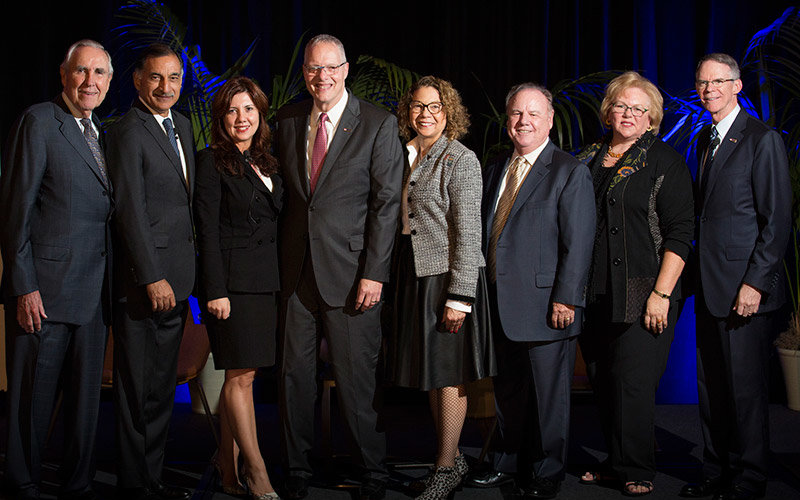
From the unexpected decision of UK voters to leave the EU, to the twists and turns leading up to this month’s presidential election, “when all is said and done, 2016 will be remembered as the year when wildly unlikely events came to pass,” said Cal State Fullerton economists Mira Farka and Anil Puri during the Nov. 2 Economic Forecast Conference, “World at a Crossroads: Navigating Risks in Pursuit of an Ideal Climate.”
Before an audience of roughly 800, both economists stressed that the common thread permeating these events is “a deep sense of resentment, anger and frustration with the status-quo” despite gains made during the current recovery.
Puri pointed to examples of stress throughout 2016: the concerns about China’s economy, worries about financial volatility and the Fed rate, the collapse in commodity prices and “on top of that, we have the election, and that has its own challenges,” he added. “Uncertainty and confusion seem rampant these days.”
Puri drew comparisons on the proposed economic plans of both Donald Trump and Hillary Clinton, noting the differences in revenue, spending, interest and debt, but noted that the greater concern for Orange County business leaders is the effect of congressional inaction. Additional details about the proposals by both candidates are available in the online report.
Farka picked up on the theme on 2016 being “a year of surprises” and noted the odds that against the passage of Brexit, as well as the Bernie Sanders primary campaign and the nomination of Donald Trump. “The one thing that is not a surprise is the low-energy ‘Jeb Bush’ recovery.
“There are no burning fires to put out, just smoldering ashes that will continue to deliver an unexciting, uninspiring range-bound growth, we have become accustomed to so far,” Farka said. To lay out the outlook for slow growth, Farka shared what seems to be a structural shift of lower growth and income stagnation since the late 1990s — well before the onset of the ‘Great Recession.’
Job growth has occurred in high- and low-income sectors, she noted, but weak for middle-income occupations. “It is no wonder that broad segments of the population have been sidelined: labor force participation rates for prime-age workers, particularly men, have declined over the past five years.
The downtrend has occurred across all levels of education, she added, but it was steepest — about 14 percent — among those with high school or less schooling. “The economy is not creating the right jobs for these people.”
Part of this has occurred because of the loss of manufacturing positions: “In 1980, manufacturing employed roughly 14 million; in 2010, it had dropped to 8.4 million,” Farka explained. The main causes, she added: “About 3.8 million was due to automation, only 1.6 million because of trade.”
And as Brexit showed, America is not alone in this fear of trade nor the stagnation of income, Farka noted. Between 65 to 70 percent of households in 25 advanced economies experienced flat or falling income between 2005 and 2014. Hence, the current backlash against globalization, trade and immigration.
“To an economist, the benefits of trade and technology are self evident,” Farka said. “They causes disruptions but the dislocation of employment is usually transitory and works out in the end.”
“The pie is getting bigger, but some are left starving,” she added. “We need to do more to help those left behind.”
Where Do We Go From Here?
As they have done for two years, Farka and Puri believe that the outlook for the U.S. economy will continue in an uneven, below-trend expansion. The second half of 2016 is expected to perform better than the first with consumer spending continuing to do the heavy lifting, buoyed by continued job growth, higher home values and better prospects for income and wages.
Other factors should also help, they say. Inventory and trade will be less of a drag; energy prices have ‘turned a corner,’ business investments should pick up and fiscal policy will contribute modestly to growth.
The full economic forecast can be found online on the Woods Center for Economic Analysis and Forecasting website.